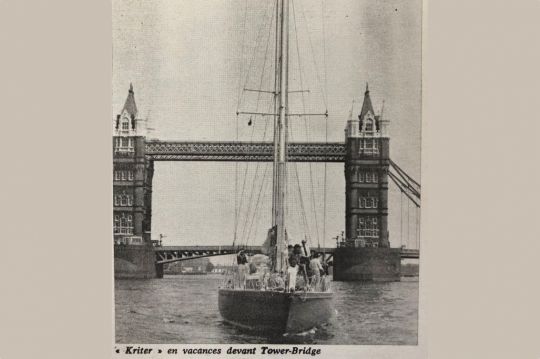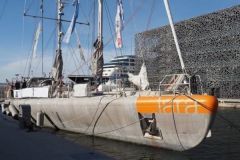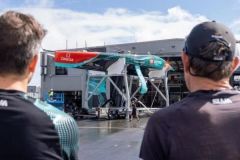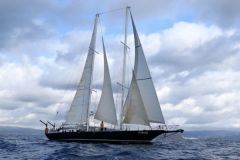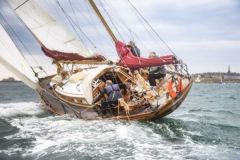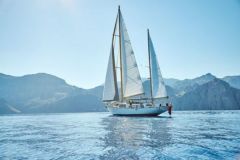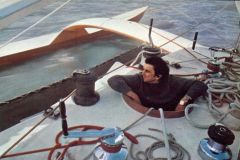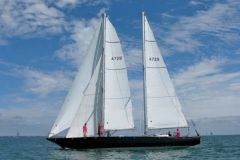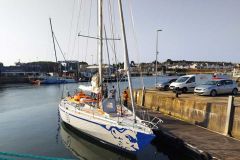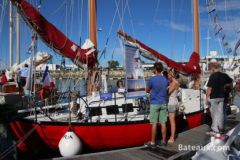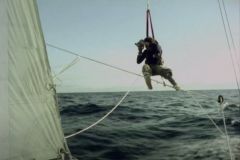A ketch to sail in the Pacific
In 1973, Jack Grout, a famous yachtsman of the 60s and 70s, decided to have a 20-meter ketch built, with which he would sail in the Pacific islands. He then approached the architect Georges Auzépy-Brenneur, to whom he asked for a sailboat inspired by the shape of Wild Rocket, a 19.3 m schooner, designed by the architect in 1972.
The boat was christened Léonard Normand III and its construction began at the "Nautic Saintonge" shipyard in Saujon, Charente-Maritime.
Birth of the first Whitbread Round the World Race
But finally, Jack Grout got wind of the creation of a new offshore race, the Whitbread Round the World Race, whose first edition will start on September 8, 1973. This round-the-world race is a crewed race with 4 legs:
- Portsmouth - Cape Town
- Cape Town - Sydney
- Sydney - Rio de Janeiro
- Rio de Janeiro - Portsmouth.
The navigator then decided to participate and asked the shipyard to make some modifications. At the same time, he approached companies to finance his project.
A new name for the sailboat
Kriter has been active as a sponsor in the world of sports since the 1960s. But the company was looking to diversify its sponsorship activities and was particularly interested in the world of ocean racing. The sparkling wine brand then decided to embark on the Whitbread adventure and sponsor the boat, which then took the name Kriter.
There will be four crews led by four renowned skippers, although Jack Grout will be in command of the boat throughout the race:
- Michel Malinovski - Portsmouth to Cape Town
- Alain Glicksman - Cape Town to Sydney
- Jack Grout - Sydney to Rio
- Alain Maupas - Rio and Portsmouth
Launching and baptism
Kriter was launched on June 2, 1973 in the port of Royan after a long (very long) trip of more than eleven hours! The size of the boat made handling and transport complicated, from the hangar - which had to be enlarged - to the winding streets.
The boat was first baptized by Father Hélias, also a sailor, and then by his godmother who broke a magnum Kriter of Brut 1969 on its hull. At the end of the day, the boat finally touches the water!
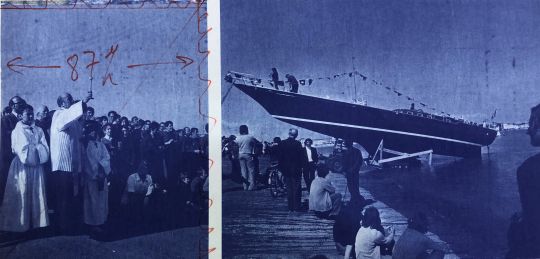
A new construction site
For three weeks, the yacht remained in the port of Royan to be masted. She then went to Honfleur, her training port, where she remained until her departure for Portsmouth on August 28, 1973. But during a dry docking, several anomalies were detected on the hull of the boat, which had just left the shipyard..
Kriter joined Le Havre for a 6-day refit, started on August 21, 1973, carried out by six of the twelve crew members. The fairing had to be completely redone, as the paint had flaked in some places, as well as the coating on the rudder and the keel. One of the propeller shafts was also misaligned, causing the welds on one of the supports to break.
The boat was finally put back in the water on August 27, before casting off for England on the morning of August 30, which it would reach during the day.
Departure of the Withbread
Portsmouth - Cape Town
The start of the first Whitbread Round the World Race was given on September 8, 1973 in Portsmouth harbor. Thousands of people were present on the water to celebrate the departure of the 19 boats, including 6 French boats, among which Kriter of course, but also Pen Duick VI led by Eric Tabarly, or Pen Duick III, in the hands of Mr. Cuiklinski.
On the first leg between Portsmouth and Cape Town, news is scarce. Kriter took the lead after Eric Tabarly's Pen Duick IV was dismasted. But tangled up in a calm zone some time later, he finally finished 9th e in compensated time on this first course.
Upon arrival in South Africa, it was learned that one of the crew members had fallen into the water, but could be recovered.
Cape Town - Sydney
For the 2nd leg, Alain Glicksman replaced Michel Malinovski at the helm of Kriter. The start was given on November 7, 1973, and Eric Tabarly barely managed to rig a new mast on his boat. Without GPS coordinates and with radios that didn't work properly, it was difficult to obtain information on everyone's positions. Thus, the intoxication reigns supreme and each one makes his prognosis on the ranking of the boats.
But this second leg reminded the sailors of the hard law of the sea. 12 days after the start, Paul Waterhouse (English crew member on the Italian ship Tauranga) fell overboard during a storm in the Indian Ocean. Four days later, the Frenchman Dominique Gillet (co-skipper of the ship 33Export) also disappeared at sea.
Kriter finished in third place, but these dramatic episodes left their mark on the crews, who were on edge. On board Kriter, Jacques Grout, who was to take the helm for the third leg, abandoned the race. The sailor was then given the choice to continue or abandon the race. In the end, it was Alain Glicksman who remained at the helm of the boat, assisted by Michel Malinovsky, who came to help him.
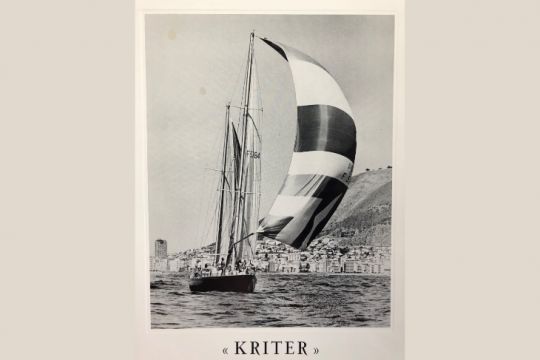
Sydney - Rio de Janeiro
The start of the 3rd leg was given on December 29, 1973, Eric Tabarly was forced to return to Sydney three days later, following a second dismasting, and abandoned the race.
The fleet suffered a lot of damage, including Kriter, who was sailing in the lead with Sayula, a Mexican ship. The crew had to continue to navigate with a bridge that had broken away and juggle with the icebergs.
When passing Cape Horn, on January 26, 1974, Kriter took advantage of a fanfare organized by the Royal Navy's surveillance ship, in charge of controlling and facilitating the passage of the famous landmass. On arrival in Rio, Sayula arrived three hours ahead of Kriter, with the boat once again finishing third e of the stage.

Rio - Portsmouth
Here comes the last stage, but this time, the fleet is separated according to the size of the boats. Kriter left Brazil with Sayula, Second Life and Burton Cutter (Great Britain). Kriter's crew reached England in 8th place and finished 4th overall in the race after 141 days and 2 hours of racing.
Michel Malinovski and Alain Glicksman will receive their trophy from the hands of Prince Philip on June 4th 1974.
